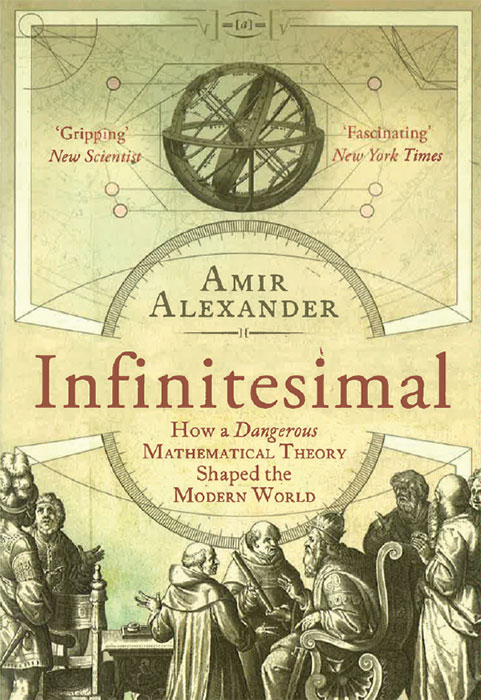By Amir Alexander
One World

Lying midway between the history and the philosophy of science, this book illuminates a fascinating period in European history during which mathematics clashed with common thought and religion. Set in the late 16th and early 17th centuries, it describes how the concept of infinitesimals – a quantity that is explicitly nonzero and yet smaller than any measurable quantity – took a central role in the debate between ancient medieval ideas and the new ideas arising from the Renaissance. The former were represented by immutable divine order and the principle of authority, the latter by social change and experimentation.
The idea of indivisible quantities and their use in geometry and arithmetic, which had already been developed by ancient Greek mathematicians, underwent its own renaissance 500 years ago, at the same time as Martin Luther launched the Reformation. The consequences for mathematics and physics were enormous, giving rise to unprecedented scientific progress that continued for the following decades and centuries. But even more striking is that the new way of thinking built around the concept of infinitesimals crossed the borders of science and strongly influenced society, up to the point that mathematics became the main focus of the struggle between the old and new orders.
This book is divided into two parts, each devoted to a particular geographical area and period in which this battle took place. The first part leads the reader to late 16th century Italy, where the flourishing and creative ideas of the Renaissance had given birth to a prolific number of mathematicians and scientists. Here, the prominent figure of Galileo Galilei – together with Evangelista Torricelli, Bonaventura Cavalieri and others – was at the forefront of the new mathematical approach involving the concept of infinitesimals. This established the basis of inductive reasoning, which makes broad generalisations from specific observations, and led to a new science founded on experience. On the opposite side, the religious congregation of the Jesuits used these same mathematical developments in its fight against heresy and the Reformation. To them, the traditional mathematical approach was a solid basis for the absolute truth represented by the Catholic faith and the authority of the Pope. The fierce opposition of the Jesuit mathematicians led Galileo and the “infinitesimalists” to damnation, with irreparable consequences for the ancient tradition of Italian mathematicians.
The second part of the book moves the reader to 17th century England, just after the English Civil War in the years of Cromwell’s republic and the Restoration. In that context, the new ideas represented by infinitesimals were not only condemned by the Anglican Church but also opposed by political powers. Here, the leading figure of Thomas Hobbes took the stage in the fight against the indivisibles and the inductive method. For him, traditional Euclidean geometry – which, contrary to induction, used deduction to achieve any result from a few basic statements – was the highest expression of an ordered philosophical system and a model for a perfect state. Hobbes was also concerned about the threat to the principle of authority that emanated from traditional mathematical thought. In his struggle against infinitesimals, he was confronted by the members of the newly founded Royal Society, eager for scientific progress. Among them was John Wallis, who considered mathematical knowledge as a “down–up” inductive system in which calculus played the role of experiments in physics. Solving many of the toughest mathematical problems of his times by infinitesimal procedures, Wallis defeated traditional geometry – and Thomas Hobbes with it. The triumph of Wallis made way for scientific progress and the advance of thought that opened the door to the Enlightenment.
This book is excellently written and its mathematical concepts are clearly explained, making it fully accessible to a general audience. With his fascinating narrative, the author intrigues the reader, depicting the historical background and, in particular, recounting the plots of the Holy See, the Jesuits’ fight for power, the Reformation, the absolutist power of the kings, and the early steps of Europeans towards democracy and freedom of thought. The book includes extensive notes at the end, a useful index of concepts, a timeline and a “dramatis personae” section, which is divided between “infinitesimalists” and “non-infinitesimalists”. Finally, the images and portraits included in the book enhance the enjoyment for the reader.








